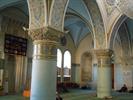Friday Mosque is located in historical part of the city – in Icheri Sheher. The mosque was repeatedly reconstructed during its existence period. A new Friday Mosque was constructed in the place of old mosque in means of Baku merchant Haji Shikhlali Dadashov, in 1899. It was constructed in place of old Friday Mosque and it is considered that it was appeared in that place, where a temple of zoroastrians located. In 1888 the Russian academician A.Pavlinov took measurements of the Juma Mosque. The mosque was built on the site of the temple of fire worshipers. Only four uncoated arches remained from the old building, they allegedly belonged to the temple. According to many modern archaeologists, there was a pagan sacred center on the site of Juma Mosque, where the fire worshipers gathered.
In the 14th century pagan temple was converted into a mosque. According to the inscription on the Mosque, "in the month of Rajab in the year 709 Hijri (1309) Amir Sharaf al-Din Mahmud ordered to update this mosque." In the 15th century, minaret was attached to the north side of the Mosque. By the end of the 19th century the old mosque came into disrepair and was replaced by a new one - Juma Mosque.
Juma mosque itself is small. There is little hall for men, women's prayer rooms. The conical dome of the building, which rests on four pillars located in the center of the Juma Mosque, is of special interest.
A minaret, constructed in 1437, adjoins Friday Mosque.
During the Soviet Union, the oldest Mosque in Baku was turned into a carpet museum. Most other mosques were torn down. In 1991, right after Azerbaijan had gained its independence from the Soviet Union, then-President Elchibey decreed that all former mosques, churches, and other houses of worship should be restored to their original, religious functions.











